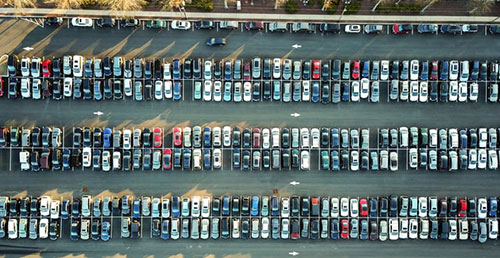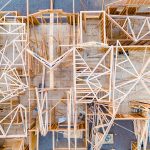The transformation of wildlands is the number one cause of natural species decline and globintercal biodiversity loss.
And this is no small thing. In fact, the planet’s biodiversity and natural ecosystems are seriously under threat.
As a matter of fact, some scientists believe we have entered what is called the 6th Mass Extinction.
This means that species are disappearing (200 a day) and natural environments are degrading at a rate equivalent to or greater than the great extinctions in the planet’s history.
And you and I should definitely be worried.
Because this massive and rapid disappearance of living species and natural environments is not just wild species probelm. It is a serious threat to human societies too.
You do know biodiversity happens to be essential to the survival of our global societies – right? Agriculture, but also pharmacy, industry and scientific research depend on biodiversity. On its richness and stability.
It is therefore fundamental to understand why biodiversity is disappearing, as well as what are the threats and dangers affecting global biodiversity.
But where exactly should we start from? From the title.
The Problem With Soil Artificialization: What Is It?
Indeed, scientific studies indicate the main risk for the natural world at this moment is the artificialization of soils and natural spaces. But why is this such a pressing issue?
The artificialization of spaces refers, in the broad sense, to a natural space that humans end up transforming.
When we build a road, residential areas or industrial zones, we transform natural spaces and make them lose their intrinsic qualities. We destroy their internal regulatory mechanisms, the habitat of the species that live there…
But the artificialization of soils is not always so obvious.
As soon as human societies interact with a natural environment, we transform or “artificialize” it.
For instance, we may think a small house inside a large a garden is trivial for nature. After all, most of the land is still “natural” and we keep the trees and even grow vegetable patches.
But for a previously virgin natural environment, this means a radical transformation will take place because of the presence of men and our actions.
In the same way, a hiking trail and an overcrowded forest are in a certain way artificialized: paths are created, soils get eroded, waste accumulates, passers-by make noise. That’s why ecoturism can be so important.
Again, this prevents natural interactions.
Ant trails might change as people constantly step on them. Animals might start avoiding places with people passing by – which can potentially affect their reproduction and ultimately the balance of entire ecosystems.
According to a recent WWF report (the Living Planet report), the artificialization of land and sea spaces is the main cause of the extinction of global biodiversity.
(Dramatic pause)
Nearly 50% of species and extinct populations are attributable to the artificialization of spaces.
(Dramatic pause)
Far ahead of the overexploitation of species (hunting or fishing – 24%), diseases or the presence of invasive species (13%), pollution (7%) or global warming (6%).
The global spread of human societies over natural areas is therefore, by far, the number one threat to global biodiversity and living species.
Hence the urgency of transforming our social and economic models so they stop invading natural spaces. Here’s how.
The Challenge of Space Artificialization and How To Fix It

The problem is that it is very complex to limit urban sprawl.
As is it to control the extension of agricultural areas or even the encroachment of tourism in nature.
Doing so would have a huge impact on cultural, economic and social trends.
For instance, in the United States, the number of housing units considered temporarily vacant—that are neither on the market, being held for future occupancy, or being used seasonally— increased by more than 50%, from 3.7 million in 2005 to 5.8 million in 2016, a Bloomberg article shows.
Despite these numbers, many new household were still being built from scratch in (what used to be) wild lands.
Either because some people were (and are) seeking to invest in individual housing and in houses with outside spaces such as gardens. Or for some other reason.
But ultimately, what matters is that there’s been an increase in the artificialisation of the land in comparison with collective housing – buildings – in the city. In many countries across the world.
And in order to serve these homes, our ecological impact and carbon footprint tend to increase.
More roads, parking lots, and other kinds of infrastructures are built. Ultimately, there’s more wild land being dometicated to serve our human habits and routines.
In short, we are building too much. Which is particularly shocking in countries such as the US that already have many vacant houses. And all this comes at an ecological price.
A little across the world, especially in less populated areas, it is often the expansion of agricultural land – and in particular the deforestation it induces – that degrades natural environments.
Fields and agricultural areas are extended to increase agricultural production. And all this is done at the expense of natural spaces. Increasing the pressure over natural ecosystems and affecting wild biodiversity.
To Solve A Global Problem We Need A Global Approach
The problem is that it is not easy to reverse these trends.
To solve the problem, it will be necessary to massively regulate the real estate market. Supervising the construction of new housing. And prioritizing collective housing, to act on the problem of vacant housing.
If only it was as easy as it sounds. Because the truth is regulations such as these are difficult to implement.
They’re unpopular and hardly compatible with the liberalization of the real estate and town planning markets that began several decades ago.
For agriculture, it’s the same thing.
“Developing” countries are looking forward to boost their economic development so they can become more profitable and improve their life quality standards.
But this always comes with an ecological cost. And increases in agricultural yields and productive areas are often the choosen ways to go.
For instance, in Brazil, agricultural commodities – soybeans and corn in particular – are among the main commodities exported. They are crucial to boost the country’s foreign trading power.
However, this increase in agricultural production is often driven by the growth of sectors that one should – for environmental or public health reasons – seek to limit. Such as the meat sector, processed products and refined carbohydrates.
Unfortunatly, limitating such industries for the sake of the people and the planet rarely works. Because short term economic development benefits too often speak too loud.
Usually, positive – and wide and impactful – measures regarding ecology always need to be thought of and implemented thinking big, holitiscally and using different (and regenerative) frameworks.
There’s no way we can make significant changes to improve the ecological situation without affecting the cultural, political, social and economic spheres too.
And it’s only through a fractural change such as the one above that we can hope to reduce the artificialization of spaces. And stop the degradation of the very ecosystems our society depends on to live and thrive.
Time for a regenerative revolution? Ask Wahl, Brewer and Elkington.
Spoiler – they’ll say yes.
[Photos by Avel Chuklanov on Unsplash and Omer Rana on Unsplash]

